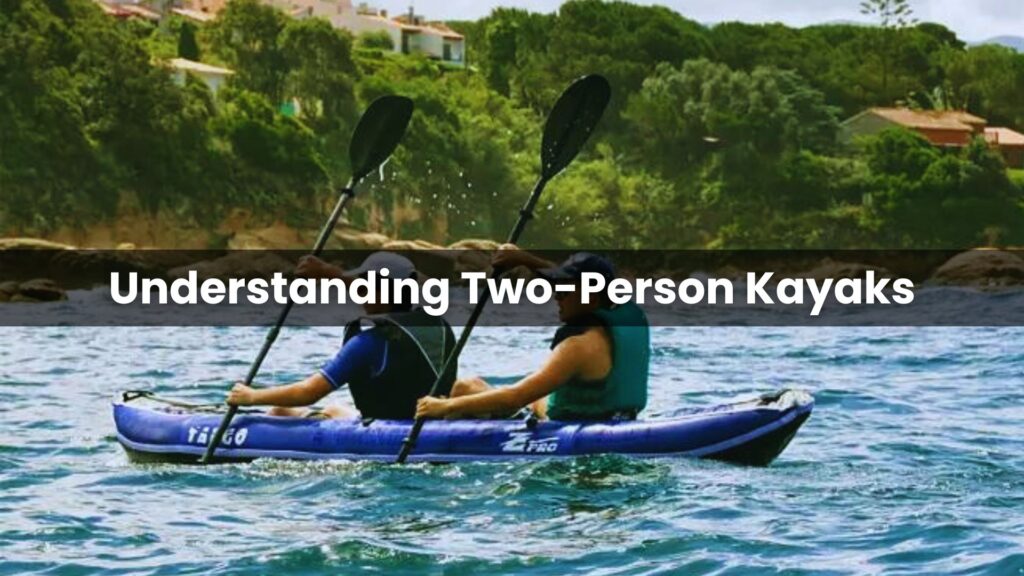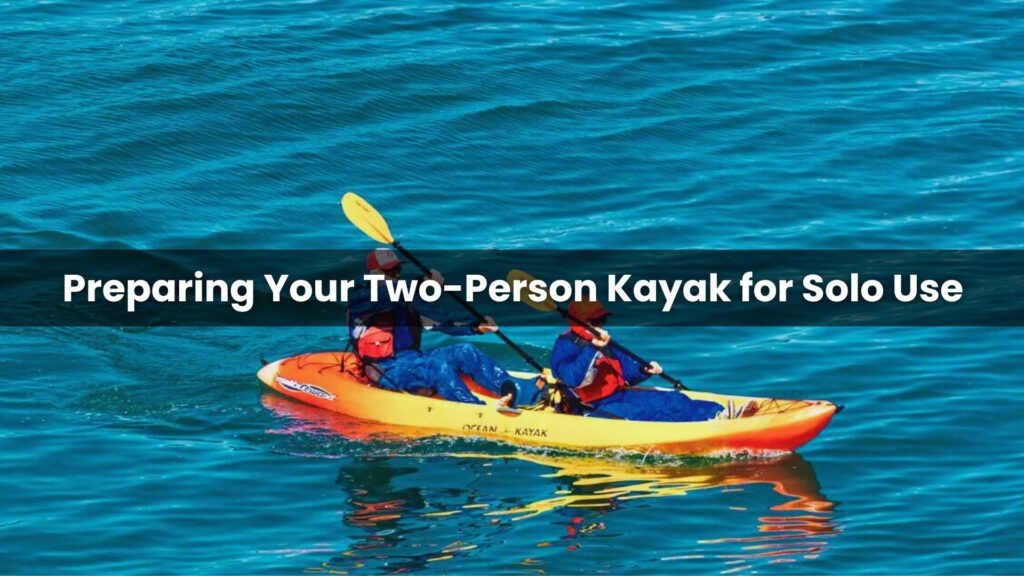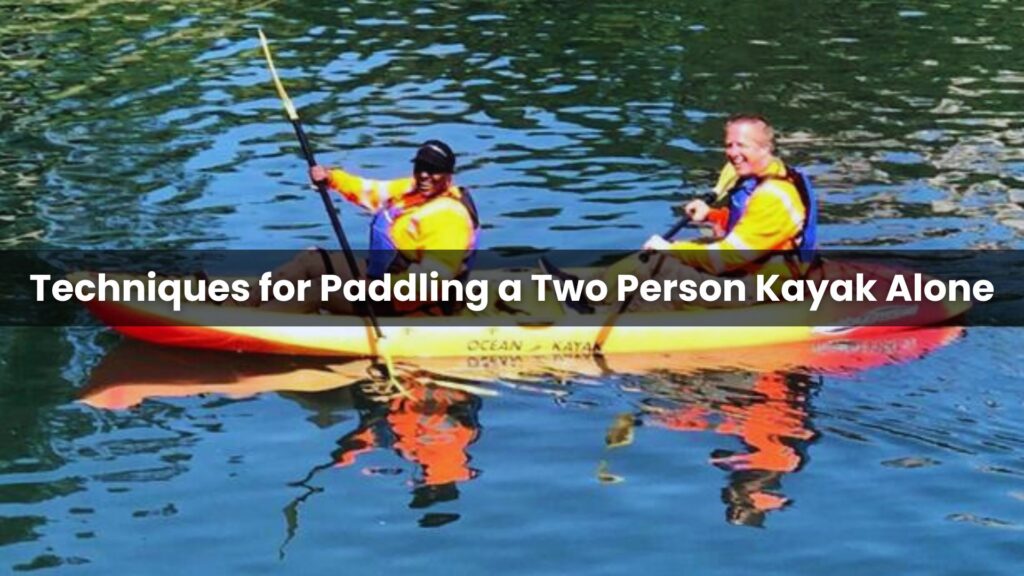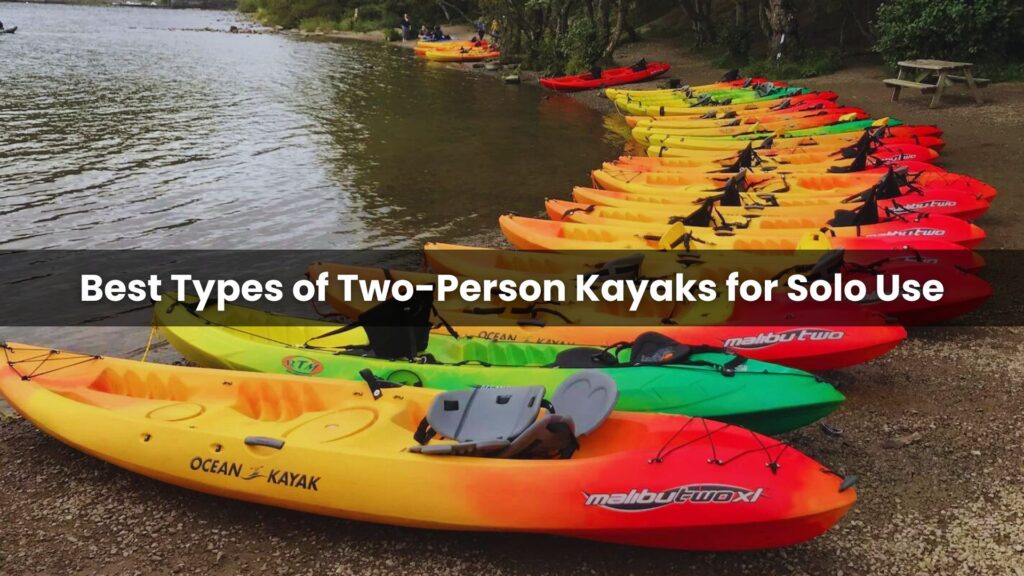Kayaking is a popular water sport that offers adventure, relaxation, and a unique way to explore nature. While most people associate kayaking with solo or tandem experiences, an intriguing question often arises: Can one person use a two person kayak?
The short answer is yes, but it’s not always straightforward. Using a two-person kayak solo presents both challenges and opportunities. This article will explore the feasibility, techniques, and considerations for paddling a tandem kayak alone, helping you decide if it’s the right choice for your next water adventure.
Understanding Two-Person Kayaks

Two-person kayaks, also known as tandem kayaks, are designed to accommodate two paddlers. These vessels are typically longer and wider than single-person kayaks, providing extra stability and storage space. The average length of a tandem kayak ranges from 12 to 18 feet, with widths between 30 to 36 inches.
These kayaks feature two cockpits or seating areas, usually positioned one behind the other. The front seat is often referred to as the bow seat, while the rear seat is called the stern seat. Each position has its own set of foot pegs and potentially a separate storage compartment.
Tandem kayaks are popular for their versatility. They’re ideal for couples, families, or friends who want to share the paddling experience. The design allows for better weight distribution and increased carrying capacity, making them suitable for extended trips or bringing along extra gear.
However, the size and weight of two-person kayaks can make them more challenging to transport and maneuver than their single-person counterparts. They often require two people to carry them to and from the water, and their length can make them less agile in tight spaces or fast-moving water.
Typical Weight and Dimensions
Here’s a quick reference table for the average specifications of two-person kayaks:
| Feature | Typical Range |
| Length | 12 – 18 feet |
| Width | 30 – 36 inches |
| Weight | 55 – 90 pounds |
| Capacity | 500 – 600 pounds |
One Person Can Use a Two-Person Kayak?
Yes, one person can use a two-person kayak. While designed for two paddlers, tandem kayaks can be operated solo with some adjustments. The paddler typically sits in the rear seat for better control and balance. This arrangement offers extra space for gear but may require more effort to maneuver due to the kayak’s larger size and weight. With practice, solo paddling a tandem kayak can be an enjoyable and versatile option for various water activities.
Preparing Your Two-Person Kayak for Solo Use

When adapting a tandem kayak for solo use, proper preparation is key to ensuring a safe and enjoyable experience. The first step is to adjust the seating position. Most solo paddlers find that sitting in the rear cockpit provides the best control and balance. If possible, remove the front seat to reduce unnecessary weight and create additional storage space.
Weight distribution is crucial when paddling a two-person kayak alone. To counterbalance your weight in the stern, place heavier gear or ballast in the bow. This could include dry bags filled with gear, water jugs, or even sand bags. Aim for a slight bow-heavy configuration, as this will help prevent the stern from dragging and improve overall tracking.
Here’s a simple guide for weight distribution in a solo-paddled tandem kayak:
| Kayak Section | Weight Distribution |
| Bow (Front) | 20% |
| Center | 50% |
| Stern (Rear) | 30% |
Adjusting the foot pegs and backrest in the rear cockpit is essential for comfort and efficient paddling. Ensure that your legs are slightly bent when your feet are on the pegs, allowing for proper leverage during strokes. The backrest should support your lower back without forcing you to lean too far backward.
Consider installing a rudder or skeg if your kayak doesn’t already have one. These features can significantly improve tracking and ease of steering, especially important when managing a longer boat solo. If adding these isn’t an option, be prepared to use corrective strokes more frequently to maintain your kayak.
Practice your paddling technique in calm waters before venturing out on longer trips. Pay attention to how the kayak responds to your movements and adjust your stroke as needed. With these preparations and some practice, you’ll be well-equipped to enjoy your two-person kayak as a solo paddler.
Techniques for Paddling a Two-Person Kayak Alone

Mastering the art of solo paddling a tandem kayak requires adaptation and practice. The key lies in understanding how to compensate for the kayak’s size and weight distribution. Start by perfecting your forward stroke, which is the foundation of efficient paddling. Keep your torso rotation smooth and your arms relatively straight, using your core muscles to power through each stroke.
Steering a larger kayak alone can be challenging, but several techniques can help. The sweep stroke is particularly effective for turning. To execute this, extend your paddle out to the side and make a wide, arcing motion from bow to stern. For tighter turns, combine a forward sweep on one side with a reverse sweep on the other.
Wind and currents have a greater effect on tandem kayaks, so learning to edge your kayak is crucial. Lifting one side of the kayak slightly out of the water reduces its profile to the wind and improves maneuverability. Practice lifting your opposite hip and applying pressure to the foot peg on the side you want to edge.
Here’s a quick reference table for essential solo tandem kayaking strokes:
| Stroke | Purpose | Technique |
| Forward | Basic propulsion | Vertical paddle entry, power from torso rotation |
| Sweep | Turning | Wide arc from bow to stern |
| Reverse Sweep | Quick turns | Opposite of sweep stroke, stern to bow |
| Draw | Sideways movement | Pull water toward kayak |
| Sculling Draw | Maintain position | Figure-8 motion parallel to kayak |
Bracing is another important skill, especially given the increased stability challenges of solo paddling a larger kayak. The low brace involves slapping the back of your paddle blade on the water’s surface to prevent capsizing. The high brace, while more powerful, should be used cautiously to avoid shoulder injuries.
Pros of Using a Two-Person Kayak Solo
While it might seem unconventional, paddling a tandem kayak solo offers several distinct advantages. One of the most significant benefits is the abundance of space. With the extra seat unoccupied, you have ample room for gear, making two-person kayaks ideal for extended trips or camping adventures. This additional space allows you to pack more supplies, fishing equipment, or even bring along a furry companion.
Stability is another key advantage. Two-person kayaks are generally wider and more stable than their single-person counterparts. This increased stability can be particularly beneficial for beginners or those who feel less confident on the water. It also provides a more secure platform for activities like fishing or photography, where sudden movements might otherwise cause instability.
The versatility of a tandem kayak is a major plus. When you own a two-person kayak, you have the flexibility to paddle solo or with a partner, depending on your needs and preferences. This adaptability makes it an excellent choice for those who sometimes enjoy solitude on the water but also like to share the experience with friends or family.
Here’s a quick overview of the main advantages:
| Advantage | Description |
| Extra Space | More room for gear, supplies, or a pet |
| Increased Stability | Wider design offers better balance |
| Versatility | Can be used solo or with a partner |
| Better for Fishing/Photography | Stable platform for various activities |
| Capacity for Longer Trips | Ability to carry more supplies |
Moreover, the length of a tandem kayak can be advantageous when paddling solo. Longer kayaks typically track better in the water, meaning they maintain a straighter course with less effort. This can be particularly beneficial on longer journeys or in windy conditions.
Cons of Using a Two-Person Kayak Solo
While solo paddling a tandem kayak has its advantages, it’s important to consider the potential drawbacks. The most obvious challenge is the kayak’s size and weight. Two-person kayaks are significantly heavier than their single-person counterparts, often weighing between 65 to 90 pounds. This extra heft can make transportation and launching more difficult, especially if you’re accustomed to handling a lighter craft.
Maneuverability is another concern. Tandem kayaks are longer and wider, which can make them less responsive to steering inputs. Tight turns and navigating narrow waterways become more challenging, requiring additional skill and effort. This reduced agility can be particularly noticeable in windy conditions or strong currents, where the kayak’s larger profile catches more wind and water resistance.
Energy expenditure is a factor to consider as well. Paddling a larger kayak alone requires more physical effort, which can lead to fatigue more quickly than when using a properly sized single-person kayak. This increased exertion might limit the distance you can comfortably travel or the duration of your outings.
Here’s a summary of the main disadvantages:
| Disadvantage | Impact |
| Weight | Harder to transport and launch |
| Size | Less maneuverable, especially in tight spaces |
| Wind Resistance | More affected by wind due to larger profile |
| Energy Requirements | Requires more effort to paddle |
| Cost | Generally more expensive than single kayaks |
| Storage | Needs more space when not in use |
The initial cost and storage requirements of a tandem kayak are also worth noting. Two-person kayaks are typically more expensive than single kayaks, which might be a consideration if you primarily paddle alone. Additionally, their larger size means they require more storage space, which can be a challenge for those with limited room.
Best Types of Two-Person Kayaks for Solo Use

When considering a two-person kayak for solo use, certain designs lend themselves better to this purpose. Sit-on-top tandem kayaks are often the most versatile choice. Their open deck design allows for easy repositioning and weight distribution, which is crucial when paddling alone. Many sit-on-top models feature adjustable or removable seats, making it simple to optimize your position for solo paddling.
Inflatable tandem kayaks are another excellent option for solo paddlers. These kayaks are typically lighter than their rigid counterparts, making them easier to transport and maneuver alone. Some inflatable models allow you to remove one seat, effectively converting them into a spacious single-person kayak.
For those who prefer a more traditional kayaking experience, some sit-inside tandem kayaks are designed with solo paddling in mind. Look for models with a larger cockpit in the rear and a smaller one in the front. This design allows you to sit in the back for better control while using the front area for storage or ballast.
Here’s a comparison of different tandem kayak types for solo use:
| Kayak Type | Solo Paddling Ease | Stability | Speed | Portability |
| Sit-on-top | High | High | Medium | Medium |
| Inflatable | High | High | Low | High |
| Convertible | Very High | Medium-High | Medium-High | Medium |
When selecting a tandem kayak for solo use, pay attention to the hull design. A slightly V-shaped hull or one with a modest keel will track better in the water, making it easier to maintain a straight course when paddling alone. Some kayaks also feature a skeg or rudder system, which can greatly improve tracking and maneuverability for solo paddlers.
Weight capacity is another important factor. Choose a kayak with a capacity that comfortably exceeds your weight plus any gear you plan to carry. This ensures proper flotation and performance, even when the kayak isn’t evenly loaded with two paddlers.
While longer kayaks generally track better and offer more storage, they can be more challenging to handle alone. A good compromise for solo use is often found in tandems ranging from 12 to 14 feet in length, balancing maneuverability with efficient paddling and ample storage.
Safety Considerations When Using a Two-Person Kayak Alone
Embarking on a solo adventure in a two-person kayak can be an exhilarating experience, but it comes with its own set of challenges and safety concerns. When considering this unconventional approach, it’s crucial to prioritize safety above all else.
First and foremost, weight distribution becomes a critical factor. Two-person kayaks are designed to balance the weight of two paddlers, typically with one in the front and one in the back. When paddling alone, you’ll need to compensate for this imbalance. Experts recommend sitting in the rear seat and using ballast in the front to maintain stability. This could be in the form of gear, water jugs, or specially designed kayak weights.
Another key consideration is the increased effort required for maneuvering. Two-person kayaks are longer and heavier than their single-person counterparts, making them more challenging to control, especially in windy conditions or strong currents.
It’s also essential to be aware of the potential for capsize. The larger size of a two-person kayak can make it more difficult to right if it flips over. Always wear a properly fitted personal flotation device (PFD) and consider taking a kayak self-rescue course before attempting to paddle a tandem kayak alone.
Here’s a quick safety checklist for solo paddling a two-person kayak:
| Safety Item | Importance |
| PFD | Essential |
| Bilge pump | Highly recommended |
| Paddle float | Highly recommended |
| Whistle | Essential |
| Spray skirt | Recommended |
| Communication device | Essential |
Inform someone of your plans before heading out. Provide details of your route, expected return time, and check in with them upon your return. This simple step can be lifesaving in case of emergencies.
Alternatives to Using a Two-Person Kayak Solo
While paddling a two-person kayak solo can be an adventure, it’s not always the most practical or enjoyable option. Fortunately, there are several alternatives that can provide a similar experience without the challenges of managing a tandem kayak alone.
One popular alternative is the convertible kayak. These versatile vessels are designed to transform from a tandem to a single-person configuration. Models like the Point 65 Mercury GTX Modular Kayak allow you to remove the middle section, creating a shorter, more manageable solo kayak. This flexibility offers the best of both worlds, adapting to your needs on any given day.
For those who enjoy the extra space of a tandem kayak, recreational sit-on-top kayaks can be an excellent choice. These kayaks typically offer ample storage and a stable platform, making them ideal for solo paddlers who want to bring along extra gear or even a furry companion.
Another option to consider is a solo canoe. While not technically a kayak, solo canoes offer many of the same benefits as a two-person kayak, including extra space and stability. They’re typically easier to manage alone than a tandem kayak and can be paddled with either a single-bladed paddle or a double-bladed kayak paddle for increased efficiency.
For those seeking high performance, touring single kayaks provide excellent speed and tracking while still offering ample storage for extended trips. These kayaks are designed for efficient solo paddling and often feature adjustable outfitting to fine-tune your fit and control.
Here’s a comparison of alternatives to solo paddling a two-person kayak:
| Alternative | Pros | Cons |
| Convertible Kayak | Versatile, adapts to solo or tandem use | Can be expensive, may have more parts to maintain |
| Recreational Sit-on-Top | Stable, spacious, easy to use | Slower, less efficient for long distances |
| Solo Canoe | Roomy, versatile, good for rivers and lakes | Requires different paddling technique, less suited for rough water |
| Touring Single Kayak | Fast, efficient, good for long trips | Less stable, may feel cramped for some paddlers |
Don’t overlook the option of renting or demoing different kayaks before making a purchase. Many outfitters offer a variety of kayak types, allowing you to test different styles and find the perfect fit for your paddling preferences and needs.
Single vs. Tandem Kayaks for Solo Use

When considering whether to use a two-person kayak solo or opt for a single kayak, it’s essential to understand the key differences between these two options. Both have their merits and drawbacks, and the choice ultimately depends on your specific needs, skill level, and intended use.
Single kayaks are designed with the solo paddler in mind. They’re typically shorter, narrower, and more maneuverable than their tandem counterparts. This design translates to better efficiency and control on the water.
On the other hand, tandem kayaks used solo offer unique advantages. They provide significantly more space for gear, making them excellent choices for extended trips or fishing expeditions. The extra length also contributes to better tracking (the ability to maintain a straight line while paddling) in open water conditions.
Let’s break down the key differences in a comparative table:
| Feature | Single Kayak | Tandem Kayak (Solo Use) |
| Length | 8-14 feet | 12-18 feet |
| Weight | 30-50 lbs | 55-80 lbs |
| Maneuverability | High | Moderate |
| Storage Capacity | Moderate | High |
| Stability | Varies (design-dependent) | Generally high |
| Efficiency | High | Moderate (depends on weight distribution) |
| Versatility | Limited to solo use | Can be used solo or tandem |
While single kayaks excel in performance and ease of handling, tandem kayaks used solo offer unparalleled versatility. Many paddlers appreciate the ability to bring along a partner, child, or pet when the occasion arises, something not possible with a single kayak.
However, it’s crucial to consider the practical aspects of using a tandem kayak solo. Transportation and storage can be more challenging due to the increased size and weight. Launching and landing may require more effort, especially in windy conditions or on beaches with steep gradients.
The decision between a single kayak and using a tandem kayak solo should be based on your primary paddling goals. If performance, ease of handling, and solo adventures are your focus, a single kayak is likely the better choice. If versatility, ample storage, and the option to bring along company are priorities, a tandem kayak used solo could be the ideal solution.
Conclusion
In conclusion, the answer to Can one person use a two person kayak? is a resounding yes with the right preparation, skills, and mindset. Whether you choose this option for its versatility, out of necessity, or simply for the challenge, solo paddling a tandem kayak can be a rewarding experience that enhances your overall kayaking journey.
FAQs About Using a Two-Person Kayak Solo
Here are some frequently asked questions about using a two-person kayak solo:
Is it harder to paddle a two-person kayak alone?
Yes, it can be more challenging due to increased weight and length. However, with proper technique and practice, many paddlers find it manageable. Adjusting your seating position and using longer, more powerful strokes can help overcome these challenges.
Can one person control a tandem kayak effectively?
Yes, one person can control a tandem kayak effectively with practice. Key techniques include mastering the J-stroke for tracking, using sweep strokes for turning, and proper weight distribution. Sitting in the rear seat or middle of the kayak often provides the best control.
How do you turn a two-person kayak by yourself?
To turn a two-person kayak solo:
- Use a sweep stroke on the opposite side of your turn direction
- Follow with a reverse sweep on the turning side
- Lean slightly into the turn
- Use a stern rudder for fine-tuning
- Combining these techniques will help you make efficient turns.
Are there any legal restrictions on using a tandem kayak solo?
Generally, there are no specific legal restrictions on paddling a tandem kayak solo. However, always comply with local boating safety laws, including wearing a Coast Guard-approved PFD and carrying required safety equipment. Check local regulations, as rules can vary by location.
What’s the best way to transport a tandem kayak alone?
To transport a tandem kayak alone:
- Use a kayak cart for moving it to and from the water
- Employ proper lifting techniques, like the “bull-carry” method
- Invest in a good roof rack system with J-cradles or stackers
- Practice sliding techniques for loading onto your vehicle
- Consider inflatable or modular options for easier solo transport
Is it safe to use a two-person kayak alone?
Yes, it can be safe to use a two-person kayak alone if proper precautions are taken. Always wear a PFD, inform others of your plans, check weather conditions, and stay within your skill level. Practice self-rescue techniques and carry appropriate safety gear. Start in calm waters and gradually progress to more challenging conditions as you gain experience.

Nigel Foster, born in 1952, is an esteemed sea kayaker, known for being the youngest to kayak around Iceland. His journey in kayaking started at 15 in Brighton, England. With a career beginning as a trainee instructor in Sussex, he later pursued teaching after attending Redland College, Bristol.
Foster’s notable expeditions include navigating the challenging waters of Newfoundland and the Hudson Strait. Despite facing intense conditions, his passion for kayaking never waned. He holds several British Canoe Union qualifications and has significantly contributed to the kayaking community through teaching and committee work.
In 1985, Foster expanded his horizons by assisting an expedition in Iceland and later founded his own kayaking business, sharing his expertise globally.
